Back in June of 2008, Union Pacific's (UP) Desoto carshop had an open house, so my dad and I headed down to DeSoto, Missouri, to take a tour of the facility.
De Soto carshop
The settlement of the De Soto area dates back to 1803, and the town of De Soto was later incorporated in 1869. The town's website says that the St. Louis & Iron Mountain and Southern Railroad (StLIM&S) came to the De Soto area in 1859 and built a depot for the town. However, Union Pacific's (UP) website states the railroad came to De Soto in 1857. Perhaps the two-year difference is due to when the railroad was first being built at De Soto and when it was completed. The first carshop was built by the StLIM&S Railway in 1865. Later the StLIM&S was merged into the
Missouri Pacific Railroad, which continued to expand and use the carshop.
 |
| A tool chest at the UP carshop in Desoto, MO. |
Today, the carshop and De Soto Subdivision, which the carshop sits along, are part of UP, which merged with the MP in 1982. The DeSoto Subdivision runs from St. Louis, Missouri to Poplar Bluff, Missouri. The town of De Soto sits about forty miles south of St. Louis, along the rail line.
Rebuilding the autorack cars
At the time of our visit to the carshop, the facility primarily was working on rebuilding tri-level autorack cars. Tri-level autoracks, as well as bi-level autoracks, are the standard railcar by which automobiles and trucks are shipped over long distances from automotive plants across North America. The American Association of Railroads (AAR) stated that almost 75% of new automobiles traveled by train in 2019.
removed, and waits to be moved into the carshop.
The autoracks undergo repairs to the cars' flatcar base and autorack structure, as well as being repainted. Before a car is moved into the shop to have work done on it the protective side screens are removed, as can be seen above.
 |
| An autorack has been raised up and set on lifts to allow for under body work. |
Once the autoracks are brought into the shop, they are lifted up off of their trucks (bogies) by a large overhead crane so that work can be done on the underside of the cars.
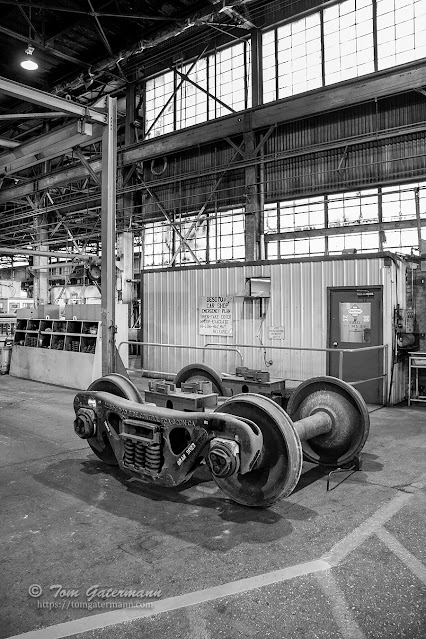 |
| A truck (bogie) sits on its own in the carshop. |
With the autoracks lifted off of their trucks, work can also be done to rebuild and repair the railcars' trucks. The truck above had been removed and on one of the wheelsets the word "scarp" had been written on it in chalk. Perhaps only the wheelset(s) were going to be replaced, while keeping the rest of the truck assembly.
 |
| Autoracks sitting on lifts while undergoing rebuild work at the UP De Soto carshop. |
In the photograph above you can see the initials TTX. TTX is a rail car leasing/pooling company. It's not uncommon for the base flatcar of an autorack to be owned by a railroad leasing company or rail car pooling company such as TTX, and for a railroad, such as UP to own the autorack structure. Some of the cars that were at the carshop were owned fully by UP, while others were owned by TTX and UP. On autoracks where a rail car leasing or pooling company owns the underlying flatcar, the leasing company's AAR code will be on the flat car and the railroads name and emblem will be on the autorack structure.
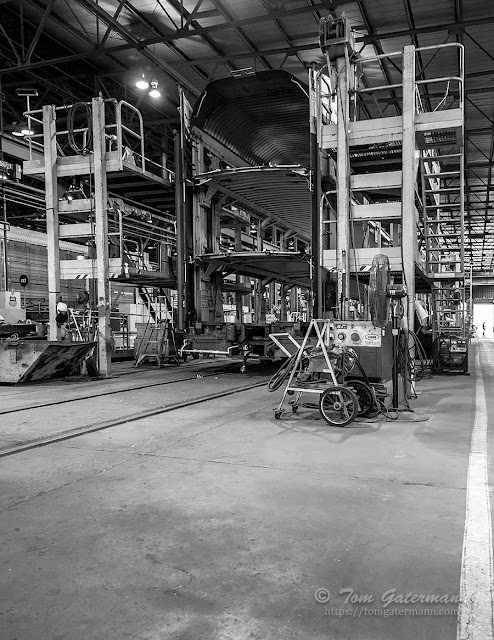 |
| This autorack is sitting back on its trucks as rebuild work continues. |
The average length of one of these autoracks is ninety feet. Closer to ninety-three feet if you include the couplers. They have a height of nineteen feet, when sitting on their trucks. The space between the three levels of a tri-level autorack car doesn't make for a lot of room. But there is just enough room to fit lots of smaller cars such as sedans and compact cars inside. UP states on its website that a tri-level autorack can hold up to fifteen cars. A bi-level autorack offers more height room for hauling up to ten trucks and sport utility vehicles (SUVs).
 |
| Looking through the lower level of a tri-level autorack that has its side grills removed. |
Blasting and repainting
During the rebuilding process, the cars are moved into a sand blasting booth where loose paint and rust is removed. I'm not sure if the blasting phase is before the cars' structures are rebuilt or if it comes after, just before the repainting process.
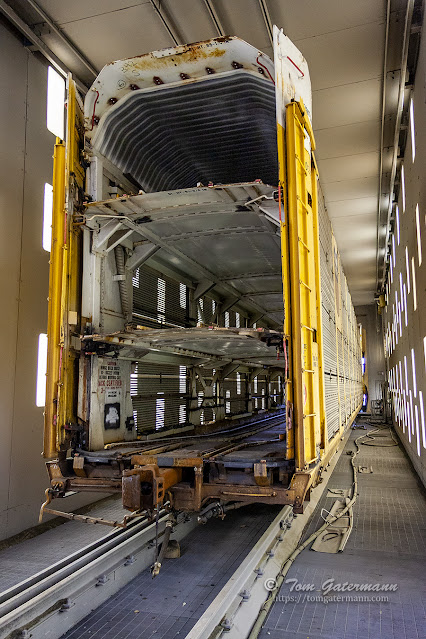 |
| An autorack car sits in a sand blasting booth where old paint is removed. |
Between December 2017, and September 2018,
a new blasting facility was built at the carshop by general contractor Millstone Weber. The project included the removal of two buildings that were built in the 1950s. I'm not sure if the blasting facility I toured in 2008 was one of the buildings that was removed.
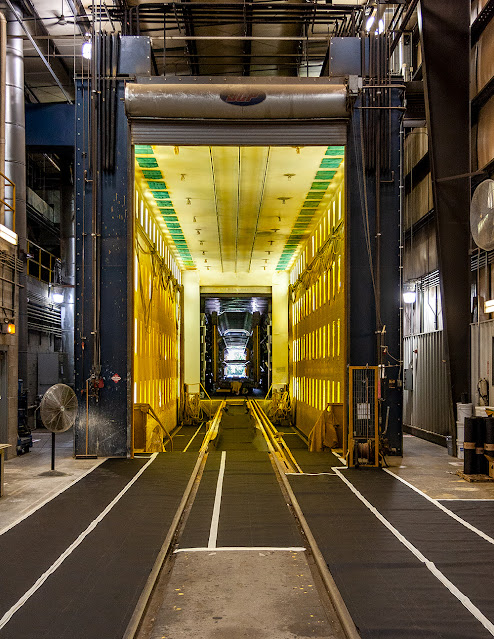 |
| Looking at a paint booth at the UP De Soto carshop. |
The photographs above and below show a painting booth at the carshop. As should be expected, the inside of the painting booth is covered in UP Amour Yellow.
 |
| An interior view of the paint booth, taken from the doorway. |
The last step in the rebuilding process is certification. Once an autorack has been certified, it will soon
be back out on the railroad hauling new automobiles.
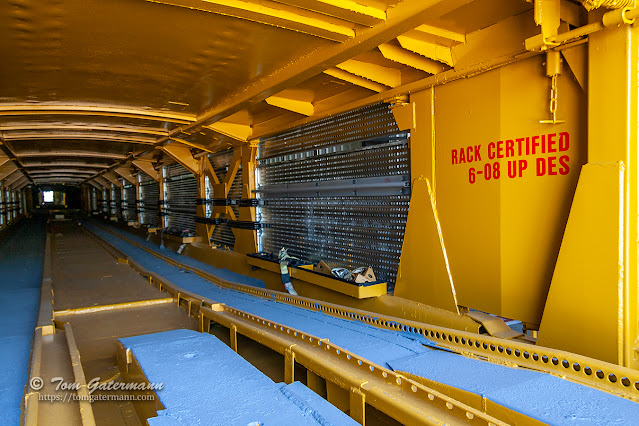 |
| After painting and inspection, the newly rebuilt cars are stenciled that they have been certified. |
Photographs taken on June 7, 2008, at DeSoto, Missouri.












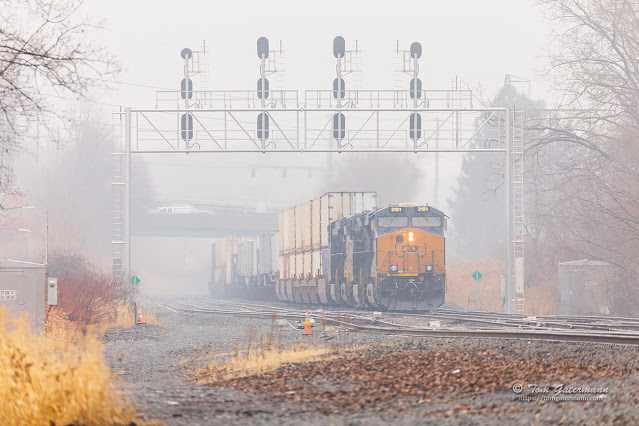


Thanks for the tour Tom
ReplyDeleteGlad you enjoyed the tour, Jim. Take care.
DeleteThat looks like a neat place to tour. Very interesting how those transport cars are done. I have been in the BNSF Shops a couple of times, once while still Santa Fe and then after the merger. The 2 look quite similar in style from what I could see in your images which makes sense. Both railroad and doing similar things.
ReplyDeleteIt was very interesting to see a side of railroading I haven't normally seen. So, much goes on behind the scenes to keep things running smoothly.
DeleteDoes UP still offer tours at the DeSoto shop.
DeleteNot that I am aware of. But, I have been away from the area for almost a decade.
Delete